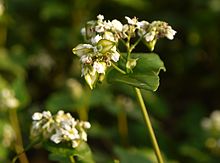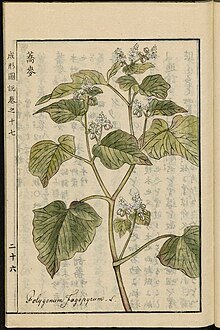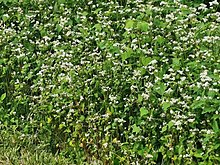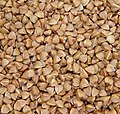Buckwheat
| Buckwheat | |
|---|---|

| |
| Scientific classification | |
| Kingdom: | Plantae |
| Clade: | Tracheophytes |
| Clade: | Angiosperms |
| Clade: | Eudicots |
| Order: | Caryophyllales |
| Family: | Polygonaceae |
| Genus: | Fagopyrum |
| Species: | F. esculentum
|
| Binomial name | |
| Fagopyrum esculentum | |
| Synonyms[1] | |
| |
Buckwheat (Fagopyrum esculentum) or common buckwheat[2][3] is a flowering plant in the knotweed family Polygonaceae cultivated for its grain-like seeds and as a cover crop. Buckwheat originated around the 6th millennium BCE in the region of what is now Yunnan Province in southwestern China. The name "buckwheat" is used for several other species, such as Fagopyrum tataricum, a domesticated food plant raised in Asia.
Despite its name, buckwheat is not closely related to wheat. Buckwheat is not a cereal, nor is it even a member of the grass family. It is related to sorrel, knotweed, and rhubarb. Buckwheat is considered a pseudocereal, because its seeds' high starch content allows them to be used in cooking like a cereal.
Etymology
The name "buckwheat" or "beech wheat" comes from its
Description
Buckwheat is a herbaceous annual flowering plant growing to about 60 centimetres (24 in), with red stems and pink and white flowers resembling those of knotweeds.[5]: 68 The leaves are arrow-shaped and the fruits are achenes about 5–7 mm with 3 prominent sharp angles.[6]: 94
Distribution
Fagopyrum esculentum is native to south-central China and Tibet,[7] and has been introduced into suitable climates across Eurasia, Africa and the Americas.[7]
History

The wild ancestor of common buckwheat is F. esculentum ssp. ancestrale. F. homotropicum is interfertile with F. esculentum and the wild forms have a common distribution, in Yunnan, a southwestern province of China. The wild ancestor of tartary buckwheat is F. tataricum ssp. potanini.[8]
Common buckwheat was domesticated and first cultivated in inland Southeast Asia, possibly around 6000 BCE, and from there spread to Central Asia and Tibet, and then to the Middle East and Europe, which it reached by the 15th century.[9] Domestication most likely took place in the western Yunnan region of China.[10]
The oldest remains found in China so far date to circa 2600 BCE, while buckwheat pollen found in Japan dates from as early as 4000 BCE. It is the world's highest-elevation domesticate, being cultivated in
Cultivation


Buckwheat is a short-season crop that grows well in low-fertility or acidic soils; too much fertilizer – especially nitrogen – reduces yields, and the soil must be well drained. In hot climates buckwheat can be grown only by sowing late in the season, so that it blooms in cooler weather. The presence of pollinators greatly increases yield.[citation needed] Nectar from flowering buckwheat produces a dark-colored honey.[12]
The buckwheat plant has a branching root system with a primary taproot that reaches deeply into moist soil.[13] It grows 75 to 125 centimetres (30 to 50 inches) tall.[14] Buckwheat has tetrahedral seeds and produces a flower that is usually white, although can also be pink or yellow.[15] Buckwheat branches freely, as opposed to tillering or producing suckers, enabling more complete adaption to its environment than other cereal crops.[13]
Buckwheat is only raised for grain where a brief time is available for growth, either because the buckwheat is an early or a second crop in the season, or because the total growing season is limited. It establishes quickly, which suppresses summer weeds, and can be a reliable cover crop in summer to fit a small slot of warm season.[14] Buckwheat has a growing period of only 10–12 weeks[16] and it can be grown in high latitude or northern areas.[17] Buckwheat is sometimes used as a green manure, as a plant for erosion control or as wildlife cover and feed.[14]
Production
In 2022, world production of buckwheat was 2.2 million tonnes, led by Russia with 55% of the world total, followed by China with 23% and Ukraine with 7%.[18]
| Country | Production (tonnes) |
|---|---|
| 1,222,382 | |
| 506,440 | |
| 147,690 | |
| 89,803 | |
| 85,305 | |
| 64,376 | |
| Total: | 2,235,193 |
| Source: FAOSTAT of the United Nations[18]
| |
Biological control
F. esculentum is often studied and used as a pollen and nectar source to increase natural predator numbers to control crop pests.
-
Field of buckwheat in Bumthang (Bhutan)
-
Buckwheat field near Vrchovina in the Czech Republic
-
Common buckwheat in flower
-
Buckwheat flower in close up (thrum)
-
Seedand withered flower of buckwheat
-
Hulled buckwheat grain
| Nutritional value per 100 g (3.5 oz) | |
|---|---|
| Energy | 1,435 kJ (343 kcal) |
71.5 g | |
| Dietary fiber | 10 g |
3.4 g | |
| Saturated | 0.741 g |
| Monounsaturated | 1.04 g |
| Polyunsaturated | 1.039 g 0.078 g 0.961 g |
13.25 g | |
Niacin (B3) | 44% 7.02 mg |
| Pantothenic acid (B5) | 25% 1.233 mg |
| Vitamin B6 | 12% 0.21 mg |
| Folate (B9) | 8% 30 μg |
| Vitamin C | 0% 0 mg |
Copper | 122% 1.1 mg |
| Iron | 12% 2.2 mg |
| Magnesium | 55% 231 mg |
| Manganese | 57% 1.3 mg |
| Phosphorus | 28% 347 mg |
| Potassium | 15% 460 mg |
| Selenium | 15% 8.3 μg |
| Sodium | 0% 1 mg |
| Zinc | 22% 2.4 mg |
| Other constituents | Quantity |
| Water | 9.8 g |
"Link to database entry". Food Details. USDA. 170286. | |
| †Percentages estimated using US recommendations for adults,[25] except for potassium, which is estimated based on expert recommendation from the National Academies.[26] | |
Phytochemicals
Buckwheat contains diverse phytochemicals, including rutin, tannins, catechin-7-O-glucoside in groats,[27][28] and fagopyrins,[29][30][31] which are located mainly in the cotyledons of the buckwheat plant.[32] It has almost no levels of inorganic arsenic.[33]
Aromatic compounds
Nutrition
With a 100-gram serving of dry buckwheat providing 1,440 kilojoules (343 kilocalories) of
Gluten-free
As buckwheat contains no gluten, it may be eaten by people with gluten-related disorders, such as celiac disease, non-celiac gluten sensitivity or dermatitis herpetiformis.[36][37] Nevertheless, buckwheat products may have gluten contamination.[36]
Potential adverse effects
Cases of severe
Culinary use
This section needs additional citations for verification. (December 2015) |


The fruit is an
Buckwheat
Buckwheat noodles have been eaten in Tibet and northern China for centuries, where the growing season is too short to raise wheat. A wooden press is used to press the dough into hot boiling water when making buckwheat noodles. Old presses found in Tibet and Shanxi share the same basic design features. The Japanese and Koreans may have learned the process of making buckwheat noodles from them.
Buckwheat
Noodles also appear in Italy, with pasta di grano saraceno in Apulia region of Southern Italy and pizzoccheri in the Valtellina region of Northern Italy.
Buckwheat pancakes are eaten in several countries. They are known as buckwheat blini in Russia, galettes bretonnes in France, ployes in Acadia, poffertjes in the Netherlands, boûketes in the Wallonia region of Belgium, kuttu ki puri in India and kachhyamba in Nepal. Similar pancakes were a common food in American pioneer days.[42] They are light and airy when baked. The buckwheat flour gives the pancakes an earthy, mildly mushroom-like taste.
Yeasted patties called hrechanyky are made in Ukraine.
Buckwheat is a permitted sustenance during fasting in several traditions. In India, on
-
Sobanoodlesmade from buckwheat flour
-
Kuttu ke pakore, a snack made from buckwheat flour, India
-
Grechkaof Russia and Ukraine and Belarus
Beverages

Beer
In recent years, buckwheat has been used as a substitute for other grains in











